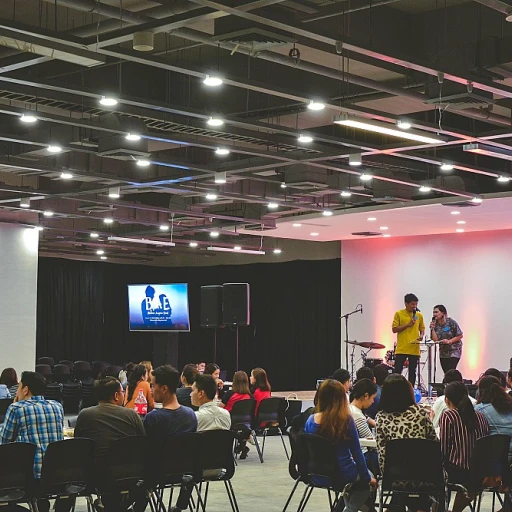
The Rise of Flexible Work Arrangements
Adapting to Flexibility Demands
In today's evolving work environments, the rise of flexible work arrangements is playing a pivotal role in creating a more intelligent and adaptable office setting. The modern workplace demands a shift from traditional 9-to-5 workdays to a more hybrid work model, blending the benefits of remote work with physical office interactions. By implementing hybrid workplace solutions, businesses can cater to diverse employee preferences, optimize space management, and enhance overall productivity. The integration of smart technology in workplace environments enables organizations to manage real-time data effectively, tailoring the workspace to better suit employee needs. For example, digital tools such as meeting room scheduling systems and digital signage can provide employees with the ability to access information and resources quickly, which in turn boosts productivity and enhances the employee experience. Incorporating smart technology not only supports hybrid work arrangements but also helps businesses create a responsive, data-driven work environment that anticipates the needs of the workforce. By understanding the importance of flexibility and leveraging innovative technology for seamless digital interaction, companies can cultivate a smarter workplace culture that places employee well-being at its core. To deepen your understanding of how these flexible arrangements impact workplace dynamics and meet evolving employee expectations, consider exploring modern workplace styles.Leveraging Technology for Enhanced Collaboration
Utilizing Technology for Seamless Interaction
In today’s fast-paced business world, enhancing collaboration through technology is essential for developing a smarter workplace environment. As the work landscape shifts towards more hybrid models, integrating digital tools becomes crucial in maintaining effective communication among employees, whether they're in the office or working remotely. Using cutting-edge solutions, companies can facilitate seamless exchanges in their work environments. Tools like digital signage and smart office platforms can transform a meeting room into a dynamic space, allowing for real-time data sharing and efficient decision-making. These tools not only boost productivity but also create a more engaging atmosphere for employees. Moreover, the integration of data-driven technologies and analytics allows management to monitor and understand team dynamics and employee experiences better. This insight leads to more informed decisions about space management, optimizing the work environment for maximum efficiency and satisfaction. The prudent application of workplace technology fosters a more connected and collaborative space, bridging the gap between traditional and modern workplace styles. By leveraging technology to create a hybrid workplace, businesses can support a diverse team and maintain a smart workplace tailored to today's evolving professional needs. For a deeper dive into how these ideas manifest in various work settings, consider exploring how the appeal of fun work environments can synergize with technological advancements to further boost engagement and productivity.Prioritizing Employee Well-being
Fostering a Culture of Well-being
In today’s fast-paced work environments, prioritizing employee well-being is vital not just for individual staff members, but for the overall productivity of a business. Creating a smart workplace that champions well-being can lead to a healthier, more engaged workforce.
Leveraging workplace technology is instrumental in this transformation. Smart tools can monitor real-time data on stress levels or ergonomic conditions, offering immediate solutions for improvement. Digital tools, such as mental health apps or integrated health platforms, help monitor employee wellness and identify areas needing attention.
Furthermore, the hybrid work model can support well-being initiatives by allowing employees to tailor remote and office work to suit personal circumstances, providing a much-needed balance and flexibility. A hybrid workplace that encourages breaks, movement, and collaboration enables individuals to work smarter, not harder.
Space management also plays a critical role. Ensuring meeting rooms and office spaces are designed with employee comfort in mind can reduce environmental stressors that hinder productivity. Implementing thoughtful space solutions, such as quiet zones or collaborative areas, promotes a more diverse and inclusive work environment.
Moreover, smart technology in the office, like digital signage, can keep teams informed with updates on wellness programs or upcoming events, fostering a sense of community and continued learning opportunities. Tailored environments and supportive management styles create a culture where employees feel valued, and their well-being is prioritized—an integral element of a smarter workplace.
Diversity and Inclusion as a Strategic Advantage
Diverse Work Culture as a Competitive Edge
In the modern workplace landscape, fostering a diverse and inclusive environment is not just a moral obligation, but a strategic business advantage. Companies are recognizing that a variety of perspectives and backgrounds can lead to more innovative solutions and a smarter workplace. By embracing diversity, businesses can enhance their overall work environment and build a team that reflects the world it serves.
The integration of hybrid work arrangements has made it easier to attract talent from different demographics, thanks to the flexibility of working from various locations. With the support of workplace technology, offices can now offer an inclusive space that accommodates everyone, regardless of their geographical or physical challenges. Digital tools such as real-time communication platforms ensure that all voices are heard, promoting collaboration among diverse teams.
Workplace technology doesn't just end with communication tools; data-driven solutions are assisting employers in better understanding their employees' needs. Through data analytics, management can identify gaps in inclusivity and create targeted strategies for improvement. This proactive approach in shaping a smarter workplace fosters a sense of belonging and encourages teams to work more productively, leveraging their differences as a collective strength.
Furthermore, a commitment to diversity and inclusion can enhance the employee experience and attract top-tier talent. As companies continue to prioritize this aspect, they position themselves as forward-thinking and socially responsible, gaining a competitive edge in their industry. By embedding diversity into their core values, businesses not only promote a smarter workplace but also ensure sustained growth and innovation.
Sustainability in the Workplace
Embracing Eco-Friendly Practices for a Better Tomorrow
Sustainability isn't just a buzzword in today's business world—it has become a critical component of creating smarter workplaces. Companies are increasingly recognizing the value of integrating sustainable solutions into their business strategies, reflecting a commitment to not only the environment but also to enhanced employee experience and productivity. Smart technology plays an essential role in driving these eco-friendly initiatives. From smart office lighting systems that adjust to the natural light and reduce energy consumption, to digital signage that minimizes paper waste, technology solutions are making offices more eco-efficient. These technology-driven improvements not only contribute to a greener planet but also create a more comfortable and efficient work environment for employees. Moreover, data analytics and data driven decision-making allow organizations to understand how resources are used in real time. This insight aids in effective space management and optimizing the use of office resources, ultimately contributing to both cost savings and environmental benefits. Hybrid work models further support sustainability by reducing the need for large meeting rooms and extensive commutes, thereby cutting down on carbon footprints. In terms of employee engagement, adopting sustainability practices can bolster team morale and foster a sense of shared purpose. Many employees are motivated to work for companies that mirror their values, and being associated with an eco-conscious organization can be a significant driver of employee satisfaction and retention. Smarter workplaces leverage these values to attract top talent and build a committed workforce. Business leaders who prioritize sustainability in their strategic planning not only pave the way for a healthier planet but also enhance their organization's competitive edge in the modern workplace. As we continue to navigate the nuances of innovative work environments, integrating sustainability remains a crucial aspect of any forward-thinking business strategy.Continuous Learning and Development Opportunities
Unlocking Growth Through Continuous Learning
In today's fast-paced work environment, continuous learning and development are crucial for achieving a smart workplace. Businesses that prioritize this aspect can boost productivity and enhance the employee experience. Organizations are now focusing on creating hybrid workspaces that leverage technology to offer real-time training and development opportunities. This approach not only keeps employees engaged but also ensures that they are well-equipped to meet the evolving demands of their roles.
Employing digital tools and solutions can make learning more interactive and accessible. From online courses to virtual seminars, technology allows employees to learn at their own pace, whether they are in the office or working remotely. Such flexibility is vital in a modern workplace as it addresses the diverse needs of a hybrid workforce, allowing for a smarter and more efficient work atmosphere.
Data-driven learning strategies are increasingly being used to tailor development programs. By analyzing employee performance and feedback, management can design personalized learning paths that address specific skills gaps and foster professional growth. This kind of targeted approach ensures that time and resources are optimally utilized, paving the way for a smarter, data-centric work environment.
Moreover, creating a culture of continuous improvement and curiosity within teams transcends beyond just learning new skills. It promotes innovation, encourages problem-solving, and inspires employees to contribute ideas that can lead to smarter solutions, impacting overall business success. In the realm of a smart workplace, continuous learning is not just an option but a strategic necessity to stay ahead in the competitive landscape.
Whether through structured training sessions or informal learning opportunities embedded into everyday work, fostering a learning-centric environment is essential for a future-proof workplace. By doing so, businesses can ensure their employees are not only adept at navigating the present challenges but are also ready to tackle the unknowns of tomorrow.













